An Argument Across the Internet: Startups, VCs and Lifestyle

I love watching an argument unfold across the Internet. Here’s a thread that bounced from evangelist-loudmouth-romanticizer to startup engineer to VC where everyone’s right and everyone’s a bit wrong too.
• “You might be sad that you work long hours and that sometimes your boss yells at you when tensions run high. But you also know that there is nowhere on earth like Silicon Valley…. There’s so much money in Silicon Valley now that a lot of non-like minded people have rolled in. Looking for easy stock options at a hot startup. They start whining when they realize that they have to give so much to make it all work.” — Michael Arrington
• “He’s trying to make the point that the only path to success in the software industry is to work insane hours, sleep under your desk, and give up your one and only youth, and if you don’t do that, you’re a pussy. He’s using my words to try and back up that thesis.
“I hate this, because it’s not true, and it’s disingenuous.
“What is true is that for a VC’s business model to work, it’s necessary for you to give up your life in order for him to become richer.” — Jamie Zawinski
• “I don’t know Jamie’s history with VCs, so I won’t speculate. But his post got me thinking about the contrast in perception vs. the reality of VC economics.
“The underlying assertion Jamie makes is that VCs stand to make far more money than certain employees when and if a company has a positive liquidity event (acquisition or IPO). So, let’s test that assertion with a simple sample case for today’s market.” — Bryce Roberts
The Pleasures (And Melancholy) Of The Late Autumn Garden
The Pleasures (And Melancholy) Of The Late Autumn Garden
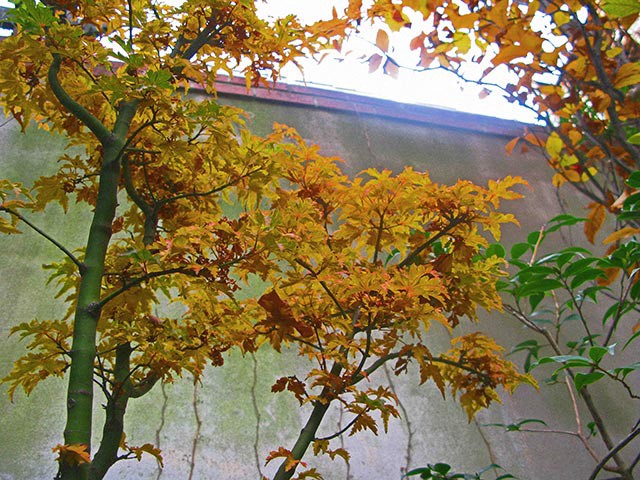
These days when I go out in the garden, I’m reminded of how, as a kid, I used to feel at the end of August, when the start of school loomed and you could already hear the gates to freedom and laziness clanking shut. As an adult, it’s a dread of winter tempered by the last of the color; the brightness is all the more striking for being found in a web of leafless, grey vines and branches. There’s a certainty that what remains is about to end.
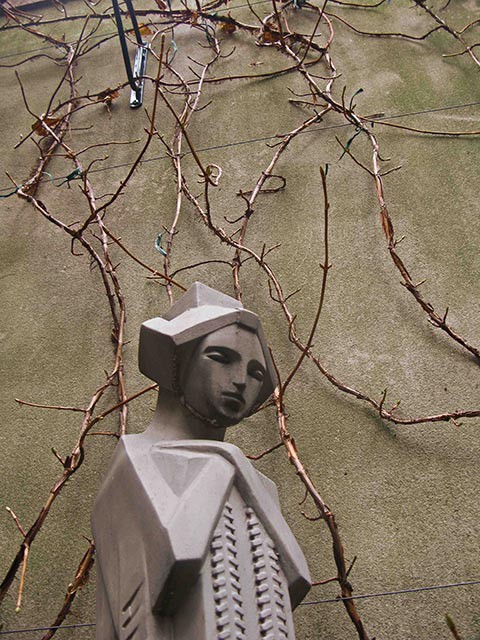
Which is not to say the vines (here, climbing hydrangea) don’t possess a stark beauty, but it’s a beauty of ruins, a memory what has been. I think having a statue helps, too (ours is a Frank Lloyd Wright reproduction), although I’m sure some gardening purists would beg to differ.
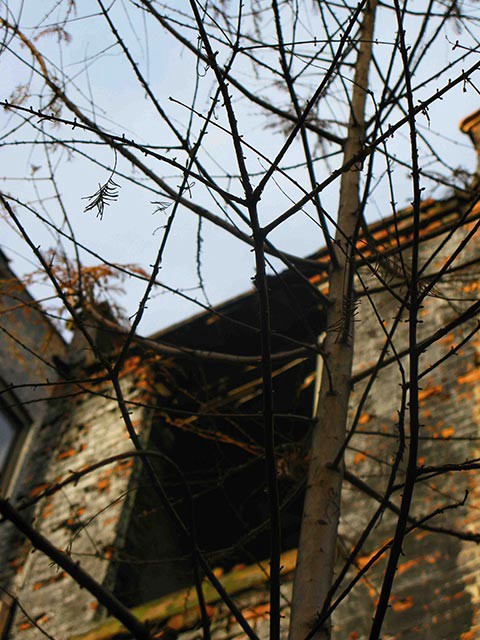
If you live near actual ruins, like I do, you can take a certain satisfaction as you stare through the branches of the dawn redwood (a deciduous conifer) toward the burned-out window of the abandoned crack house next door.

Not everything is so grim; there are stellar patterns to be found in the yellowing leaves of the azalea, and already the center of each whorl contains a bud.

Late autumn is also a time of taking stock. This year we lost the leading branch of our “Eskimo Sunset” (a highly variegated cross between a Japanese maple and sycamore) to some sort of pest, but fingers crossed the tree itself seems to have recovered nicely.

Another benefit of the garden at this time of year is the intensity of orange (found here in the firethorn berries), which you just don’t see in the spring or summer, or at least not around here.
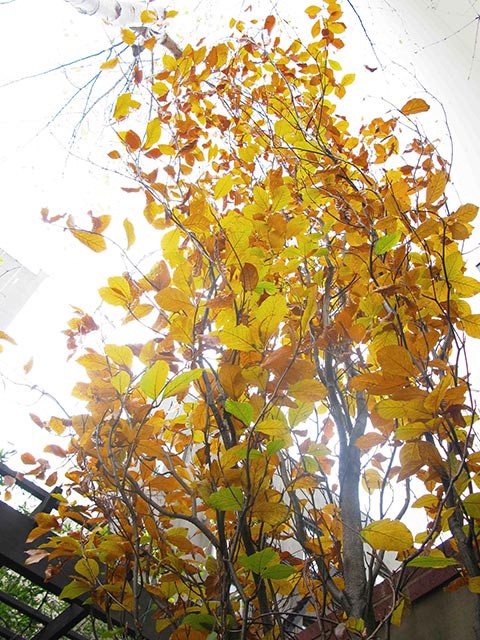
The same could be said of the golden hues of the columnar beech tree. Ours also had a rough summer (I mean: didn’t we all? it was the hottest on record, which you probably don’t want to remember) fighting off some sort of spidery infestation, but it now seems happy enough. The beech can live for hundreds of years, so it would be a tragedy (at least in terms of the garden) to lose it at such a young age.

Then there are the conifers, which, for staying green all year round, must be considered the optimists of the garden (or perhaps the insomniacs). They actually look forward to the snow, which is why we must regard these trees with equal parts admiration and skepticism — they’re not the kind of someones you’d necessarily want to start a business with. And finally it’s important to acknowledge the moss, which as it slowly creeps over the brick reminds us that all paths lead to the same end.

Matthew Gallaway is the author of The Metropolis Case and the director of Remembrance of Things Past.
The News Industry Of 1940
“Covering a fire is usually an exciting event. But it doesn’t come nearly as often as you might think. Amid the turmoil and confusion, the reporter must be able to think clearly and quickly, and he must get his facts accurately. Assignments of this type may keep the reporter out in bad weather for many hours of hard, tiresome work. But there’s a real thrill in seeing your own byline over a story when it’s in print.” Also noted: reporting is hard for girls. [Via]
Get Ready For The Return of Voltron
Are you ready for the coming Voltron renaissance? For some of us, Voltron needs no renaissancing, because it has always been with us, like Jesus. But the rest of you can considered yourself warned.
CEO Says CEO Thing

Let’s play compare and contrast!
Mark Zuckerberg: “Recently, the US Federal Trade Commission established agreements with Google and Twitter that are helping to shape new privacy standards for our industry. Today, the FTC announced a similar agreement with Facebook.”
The government: “The social networking service Facebook has agreed to settle Federal Trade Commission charges that it deceived consumers by telling them they could keep their information on Facebook private, and then repeatedly allowing it to be shared and made public. The proposed settlement requires Facebook to take several steps to make sure it lives up to its promises in the future.”
It's An Underwater Babies Kind Of Day
Here you will find a photogallery of babies swimming underwater.
Class, Strategy And Shopping: What Happened At Occupy Black Friday
by Susie Cagle

After weeks of what Shon Kay at one point described to me as “march, cops, march, cops,” this was going to be something new. Occupy Oakland was going shopping.
Shon has been an integral member of the Occupy Oakland media committee since its inception. When I hear critics say OO doesn’t understand media relations, I think of people like Shon — and I think of plans like this one, and their role in the days since all the encampments were cleared.
Over the course of the week prior, Shon organized a group of participants who planned strategy. Last Friday, on the busiest shopping day of the year, about 25 gathered in the bustling parking lot outside the Emeryville Target in the late afternoon. One by one they filtered into the store, took carts, and began shopping. Twenty minutes later, they moved back to the registers, leaving full carts in the lines. Then it was on to IKEA for more of the same, plus a dual banner drop. Shon told me the idea was spawned by the emergence of “the meme of the tent.” He and others decided to “shop for all the tents in a store but then just use them to symbolically block all the shopping,” nearly two weeks after riot police removed all the tents blocking the public plaza in front of Oakland’s city hall.
I followed the group and cautiously tweeted the action as it moved from Target to IKEA to the Emeryville outdoor mall, Bay Street. Security and Emeryville police moved in quickly at Target; the banner drop on the parking structure at IKEA lasted mere minutes.
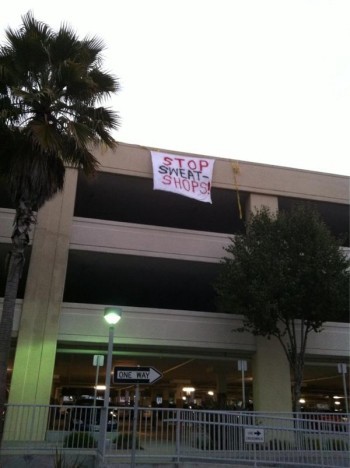
Customers snatched up the glossy flyers. A few even ran, grinning, toward occupiers handing them out. The flyers and banner drops were meant to make the action “less of a random drive by and more of a balanced statement,” Shon said.
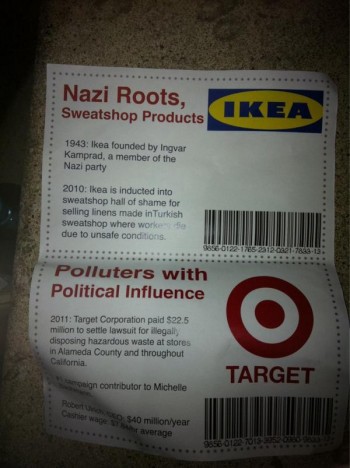
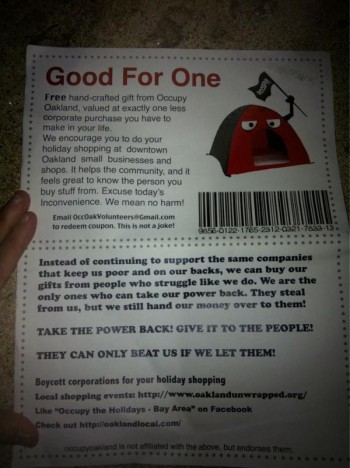
“Excuse today’s inconvenience. We mean no harm!”
Passion has been running Occupy Oakland for the last two weeks. After the initial raid on October 25, the city cleared the plaza for the second time in the early morning hours of Monday, November 14. Without a camp, Oakland’s strategic actions are more important than ever; they are the only physical manifestation of Oakland’s occupation. But the high stakes have brought high pressure. Instead of that passion being channeled into meaningful and coordinated actions, I’ve seen great ideas rushed and bungled, like a failed West Oakland foreclosure defense that devolved into men throwing canned food, then fist fighting, then break dancing in the middle of the street.
That small proclamation of no harm is arguably the closest Occupy Oakland has gotten to a non-violence resolution since its inception on October 10th.
***
Despite the raids and chemical weapons, the barricades and the blood, Occupy is still a PR war.
Something I’ve heard often in Oakland: “The whole world is watching us!” This is most often followed by either a fantastic idea or a hellish one.
Something else I’ve heard often in Oakland: “This is gonna go viral!”
What tends to be popular among the masses — that beloved 99% — is 1. cute, and 2. funny. While marches, strikes and physical occupations of public spaces are central to Occupy’s success in the immediate future, so is its perception amongst the public, many of whom are growing weary of marches, strikes and physical occupations of public spaces. Not to mention those are the top three places riot police go to beat on protesters. Mayhem and humor have the power to change the conversation and the tone of a political protest, if not an entire movement. Steve Lambert and the Yes Men distributed tens of thousands of fake New York Times on street corners in an act of “culture jamming” in 2008. A couple weeks ago, Mark Read’s Occupy Wall Street bat signal was a new kind of public relations success for the movement. It was not laying ones body on the gears, but guiding popular attention with an actual light, a signal.
Improv Everywhere founder Charlie Todd was “a small part” of that New York Times action. “I was blown away by the scope of what they pulled off,” he told me.
Over the year’s, Improv Everywhere has been responsible for a wide variety of public pranks and creative projects, from flash mobs that freaked out Best Buy to Star Wars guerilla theater on the subway. “The large majority of our projects have been unauthorized, unpermitted and unannounced. I think the public should be allowed to use public spaces as stages to express themselves creatively. If our sidewalks and subway platforms can be covered with advertising, they should also be acceptable venues for harmless creativity.”
Retail spaces are about as public as city plazas these days as far as Occupy is concerned: you can be there for a while, and then they will kick you out.
***
Black Friday did not mark but coincided with a shift in the nature of Occupy, following a spate of police violence across the country. After regrouping, new strategies — creative, and less confrontational ones — seemed welcome. Buy Nothing Day protests on the day after Thanksgiving have been a staple since the ’90s, with various demonstration incarnations over the years. Over the course of the day, other Oakland occupiers visited Emeryville retail to do their own guerilla theater, and to protest the mall’s construction on a Native American burial site with flyers disguised as coupons. Shon described his action as “a mashup.”
In San Diego, Tampa, El Paso and other cities, occupiers mic-checked Wal-Mart shoppers with information on the store and its labor practices.
San Francisco occupiers blocked streets in the downtown shopping district.
https://www.youtube.com/watch?v=9BlS67ruylk
In Chicago, occupiers led a teach-in outside a Sears.
One of Occupy’s biggest problems has been figuring out how best to reach out to the rest of that mythical 99% — the ones so pumped to get deep discounts on electronics that they camp out for days and mace each other in the face. Plus of course all the ones who wait peaceably in the long lines to make purchases, necessary and otherwise, that they might otherwise not be able to afford in this economy were it not for that day of deep discounts.
Also: the ones who work the registers for the mace-sprayers fleeing with their Xboxes.
How do you attack consumerism without attacking consumers — or workers?
During and after my coverage of the Occupy Oakland action in Emeryville, several people wrote to me on Twitter over the weekend expressing concern; the majority were retail workers themselves, annoyed at the extra work of having to replace large amounts of stock on an already very busy day. A common refrain was, “We’re the 99% too.”
Charlie Todd again, on Improv Everywhere: “I’ve seen some criticism that some of our retail pranks were rude towards the minimum-wage workers in the stores, but those workers usually react very positively to something fun happening during their work day. The managers and security guards at Best Buy called 911 and threw us out, but the average employees were laughing and taking photos when their bosses weren’t looking. I worked retail for years, and I know I always appreciated breaks in the normal routine of working the floor. I do think it’s important for protesters staging stunts in retail stores to consider everyone involved.”
https://www.youtube.com/watch?v=KgUIbPfhSuo
When I asked him about the Twitter criticisms I heard, Shon was incredulous — were these people from Occupy Oakland? I said I didn’t think they were.
“It is very easy for disengaged people to rest their heads on the pillow of criticism.”
The Internet is certainly full of armchair revolutionaries, but lately Oakland’s occupation is full of cardboard-on-cold-concrete revolutionaries — although over the last week, not quite enough of them to meet quorum at the general assemblies. Occupy Oakland needs to convince warm bodies to come out into the cold. Shon is confident that more creative actions are the future of the movement, at least here, and an effective form of outreach to the greater public. He said this was “an experiment, a template, a model.” “I see every new action that is done in this movement as one.”
For next time, I might suggest: try making them laugh.
Susie Cagle is a journalist and editorial cartoonist with pending misdemeanor charges from the county of Alameda. She is livetweeting this revolution from Oakland, CA.
What Do the Salafists Want? On Egypt, Sharia and Israel
by Christian Vachon

Translation: “The Salafi movement invites you to pray Eid prayer with us. First prize is a surprise. There will be space for females and gifts for children.”
Today is the second day of voting in Egypt for the People’s Assembly, which has 508 seats. All told, 24 days of polling will take place over the next few months. In January, elections will begin for Egypt’s upper house, the Shura Council, which has 264 seats. After that election concludes, voting will take place to choose a president.
Before the revolution, Islamic parties were banned from public office in Egypt. Now the Al-Nour party claims to have 300,000 active members, each of whom donates £10 (about $1.60) a month to maintain the party’s political and humanitarian outreach operations. Their Alexandria headquarters is an office suite on the second floor of a block concrete residential building. Inside, fresh candidate banners are strung along the walls of hastily decorated rooms with recently delivered black foam office chairs, still in their plastic wrapping.
Before the revolution, Nader Bakr was a project manager in the health care industry with a business and economics degree from the University of Alexandria. Now, at 28 he is the head spokesmen for the Nour party. His frequent appearances on Egyptian television have made him one of this election’s more recognizable faces.
In a country of abysmal dental care, Bakr’s set of unnaturally white and perfectly straight teeth are almost distracting. This same meticulous care is paid to each detail of his appearance; his trimmed black beard and crisp cream suit and silver cufflinks. It is a presentation which seems engineered to defy Western preconceptions of how a fundamentalist should appear.
The Awl: How would you define the term Salafi?
Bakr: The main concept behind Salafi is that there was a time when the Islamic societies were the best ones, all over the world.
The Awl: You mean the Uma?
Bakr: Yes. Salifism is an attempt to recover this best state of Islam itself.
The Awl: You are referencing a pan-Arab, Islamic kingdom. Is the model for the Uma the same today?
Bakr: No.
The Awl: So what would this look like today?
Bakr: Our strategy for Egypt and for Tunis and Libya is for a modern society — a modern country that has the newest scientific advances, but at the same time is conservative about its religion, instruction and duties. By conservative, we mean the keeping of the origins of Islam, not as extremism. It would be something like the European Union.
The Awl: What are the differences between the Muslim Brotherhood and the Salafi groups?
Bakr: They are both talking about the same point when it comes to Islam. They are both Muslims, they’re both Sunna. They both have the same overall strategy. The only difference between them and the Muslim Brothers is the tools through which to reach their goal in going back and keeping the origins of Islam.
The reason why before the revolution you never heard the term Salafi was because the old regime did not allow for democracy. This is why the Muslim Brothers — they were not a part of the old regime, but they were trying to be involved in politics. [The Muslim Brotherhood held 88 seats in the People’s Assembly elected in 2005, but only one seat in the Assembly elected in 2010, which was dissolved in February of this year.]
The Salafis felt they would be more of hypocrites if they got involved — and as only as decoration. They’d rather step back and not be involved because they see it as misleading. But the overall strategy is the same —
The Awl: Of spreading the Uma.
Bakr: Yes, restructuring the whole of society. We wanted to change, so the overall picture of Egypt at this time was not enabling us to change.
The Awl: With the control the National Democratic Party had over elections, it would not allow you to create change? [The NDP, founded by Anwar El Sadat in 1978, was dissolved in April of this year.]
Bakr: Corruption was everywhere. Corruption in the election process. Corruption in all the ministries.
The Awl: So now you are participating. The Muslim Brothers are also participating, but there are currently four Salafi parties in addition to the Muslim Brothers. How are they different?
Bakr: This is the first time we have had a real election, and this is why there are many Islamic parties running. The parties all have the same principle, which is the restoration of Islam. But priorities are different, and this is for the benefit of the public.
The Awl: When we look at the Middle East today, there are many different interpretations of Islamic societies. What is your vision of this correct interpretation of the proper Islamic society for Egypt?
Bakr: The official language of Egypt will be Arabic. Islamic Sharia is the main source for the Constitution — the main source of judgment and main source of law in Egypt. Also, the third point is to reserve all the rights for the minorities in Egypt, which are Christians. The fourth point is to preserve the origins of Egyptian culture; literature and art.
The Awl: When Americans see the Middle East, they see a wide range of interpretations of Islamic states — with Saudi Arabia on one end of an extreme and Turkey on the other. Where should Egypt fall?
Bakr: The Iranian regime we completely refuse. This regime is not an Islamic one. They have a king or ruler whose authority is not questioned. The ruler or king must be questioned — people must question him. Also, the Saudi model is not one that we would want to pick. We disagree with the absolute power that the king has. In terms of ethics, there is no current example of a nation that represents Islam in its purest form.
The Awl: How would foreign policy be guided in a Salafi government?
Bakr: Before we were following in Western footsteps, but not our own. We would like to have a connection with the West, but with our own independent identity. We will respect all international treaties. We would strengthen our relationships with Islamic countries, especially with those in Africa.
The Awl: Does this extend to the peace treaty with Israel?
Bakr: We will follow the treaty between Egypt and Israel, except when it comes to exporting natural gas. We will not follow these aspects of the treaty because this was an under-the-table deal made by the old regime.
When I say we will respect the treaty between us and Israel, that does not mean that we will not support Palestine, Lebanon and Syria if those countries were attacked by Israel. We will respect the treaty but on the other hand, we will respect the legal right of Palestine, the legal right of Lebanon and also of Syria.
The Awl: So in the event of a conflict between other Arab countries and Israel, Egypt would support the Arab countries.
Bakr: We will support those countries in an international, diplomatic way.
Christian Vachon lives in Cairo. He posts regularly to Twitter.
Danny Brown, "Blunt After Blunt"
The escaped Bengal tiger last seen terrorizing suburban Portland, Oregon two months ago in Stephen Malkmus’ “Tigers” video has been found in a Detroit basement. Apparently, whatever tranquilizer the animal control agent used to temporarily subdue him has led to the development of a serious drug addiction. And turned him into rapper Danny Brown, who is excellent.
It’s interesting that this video, which was directed by newly-minted millionaire ASAP Rocky, comes so closely on the heels of the one for “Another Blunt,” from Brown’s pal and fellow Detroit rapper Quelle Chris. Note the similarity in theme.
If you’re surprised that a tiger might venture from Portland to Detroit, don’t be. They are a species that can be comfortable in a wide range of environments. As Caroline Alexander writes in her article about the struggle to save tigers from extinction:
Tiger tracks have been found in Bhutan above 13,000 feet, an altitude overlapping the domain of the snow leopard, while tigers in the saltwater mangrove swamps of the Bangladeshi and Indian Sundarbans are powerful swimmers and have learned to supplement their diets with marine life.
Alexander traveled to India, home to over 50 percent of the world’s 4,000 surviving wild tigers, to visit Ranthambore National Park, outside the city of Jaipur in the northwestern state of Rajastan. There are 41 tigers living in Ranthambore’s tiger reserve, and Fateh Singh Rathore, assistant field director of the park, is very passionate about their conservation.
“I want it in my will,” Fateh Singh Rathore had told me in Ranthambore, his eyes burning bright behind his spectacles. “When I die, you spread my ashes on these grounds so the tiger can walk upon my ashes.”
That would look something like Danny Brown’s video.
Here Is What To Get Rich People For Christmas
“[T]he most popular gift that all income groups want to receive is money, either in the form of gift card, check or gift certificate. Ranking second was clothing. Among those worth $800,000 to $1.49 million, the third most popular gift is an iPad or similar tablet computer. For the $6 million or more crowd (the real one-percenters), the second most popular gift is books or CDs. Fine jewelry was more popular with the affluent than the one-percenters (only 2% of the one-percenters want jewelry this season, compared with 8% for the affluent). Yet the one-percenters are twice as likely to buy sport equipment.”
